Data Brief 2022-003 | February 14, 2022 | Written and compiled by Leila Gonzales and Christopher Keane, AGI
Download Data Brief
COVID-19 Impacts on Geoscience Business Staffing Through 2021
Staffing
While the rate at which companies expected to increase permanent
staffing grew during the first half of 2021, companies became more
cautious from August through October 2021 over concerns of impacts from
the Delta variant. Growth expectations returned starting in November and
December 2021 prior to widespread concerns about Omicron.
Throughout the pandemic, plans for temporary and contract staffing have
been more variable than those for permanent staffing. Most of the change
in expectations for temporary and contract staffing were shifts from
increased and decreased expectations. This variability is to be expected
given the inherent flexibility the temporary labor provides and the
ability for companies to adjust to changing conditions. In general, more
companies were expecting increased temporary and contract staffing than
decreased staffing through late 2020 and into 2021, at which
expectations became steady with 10% expecting decreases and 20%
expecting increases in temporary staffing. The increased stability in
permanent staffing in late 2021 is reflected with a commensurate
decrease in temporary staffing expectations at the same time. By
December 2021 permanent and temporary / contract staffing level
expectations began to resemble pre-pandemic expectations from February
2020.
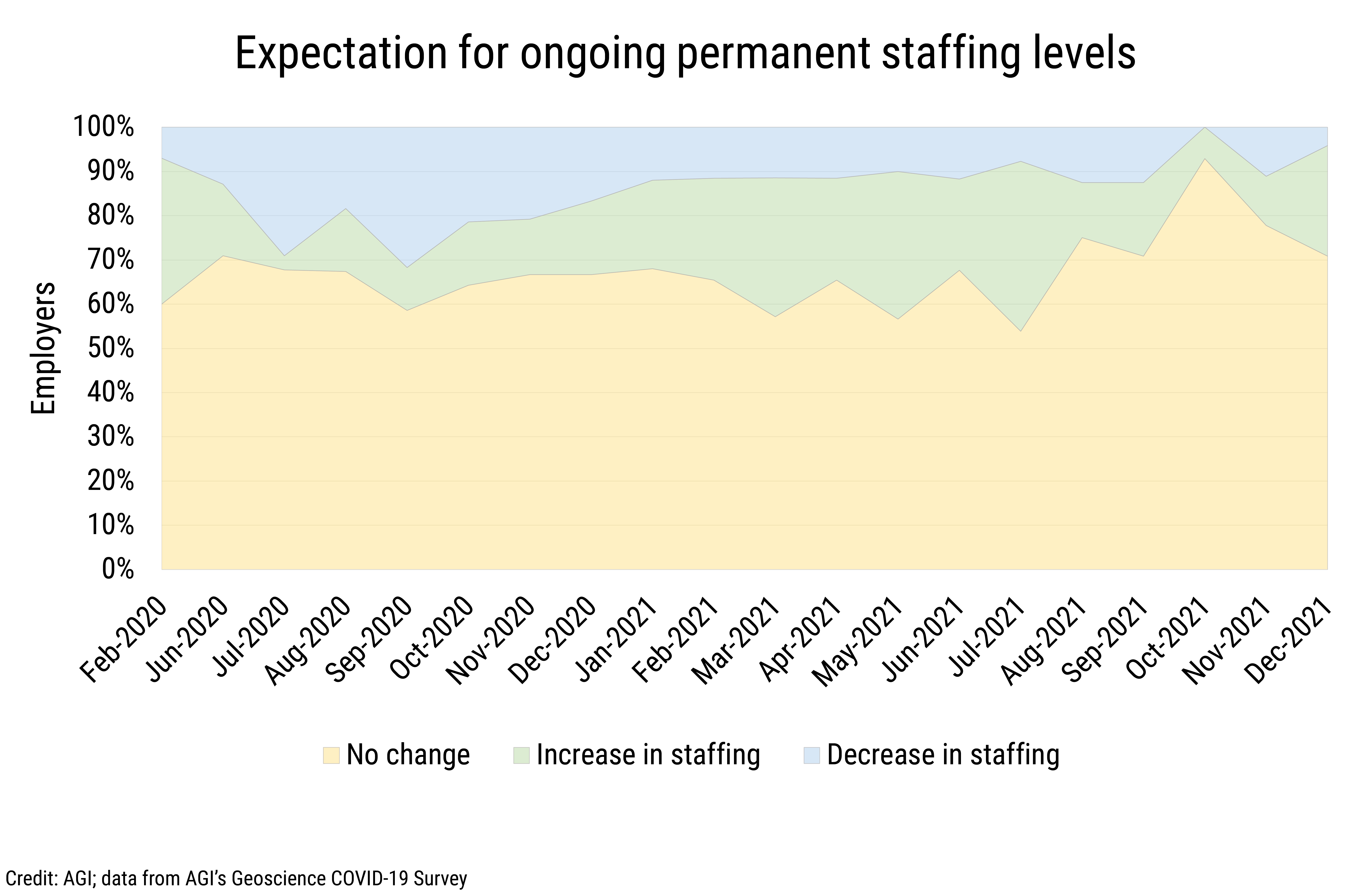
DB_2022-003 chart 01: Expectation for ongoing permanent staffing levels (Credit: AGI; data from AGI's Geoscience COVID-19 Survey)
AGI

DB_2022-003 chart 02: Expectation for ongoing temporary/contract staffing levels(Credit: AGI; data from AGI's Geoscience COVID-19 Survey)
AGI
Pandemic-related staffing impacts such as layoffs, furloughs, and
reductions to benefits and salaries declined steadily through 2020 and
into early 2021 with a temporary peak in March 2021 timed with the end
of PPP loan coverage for many employers. As layoffs and furloughs
declined through 2021, the proportion of employers reporting hiring
freezes increased and remained steady at around 10% of employers for the
last half of 2021. Active hiring picked up in Fall 2020 and accelerated
through Summer 2021 but faded with the increasing impacts of the Delta
variant, only to pick up again by the end of 2021.

DB_2022-003 chart 03: COVID-19 impacts to staffing (Credit: AGI; data from AGI's Geoscience COVID-19 Survey)
AGI
Travel and Workplace Policies
Throughout 2020 and 2021, at least half of employers reported their
employees were travelling or working in the field. From June 2020
through March 2021, more employers had travel and field restrictions
than did not. Since March 2021, substantially more employers have had no
restrictions on travel and field work than do, with only 17% reporting
restrictions in December 2021.
The proportion of employees travelling or conducting fieldwork declined
from 61% in June 2020 to 39% in December 2021. A primary driver for not
traveling or conducting fieldwork has been employees’ decisions not to
do so. The prevalence of institutional policies preventing travel and
fieldwork declined through 2020, with a peak in February 2021 that
corresponded with an increase in governmental policies. Although
institutional and governmental prohibitions diminished through 2021,
the percentage of employers reporting employees not travelling or
conducting fieldwork due to personal decisions persisted, ranging from
47% in May 2021 to 20% in November 2021.
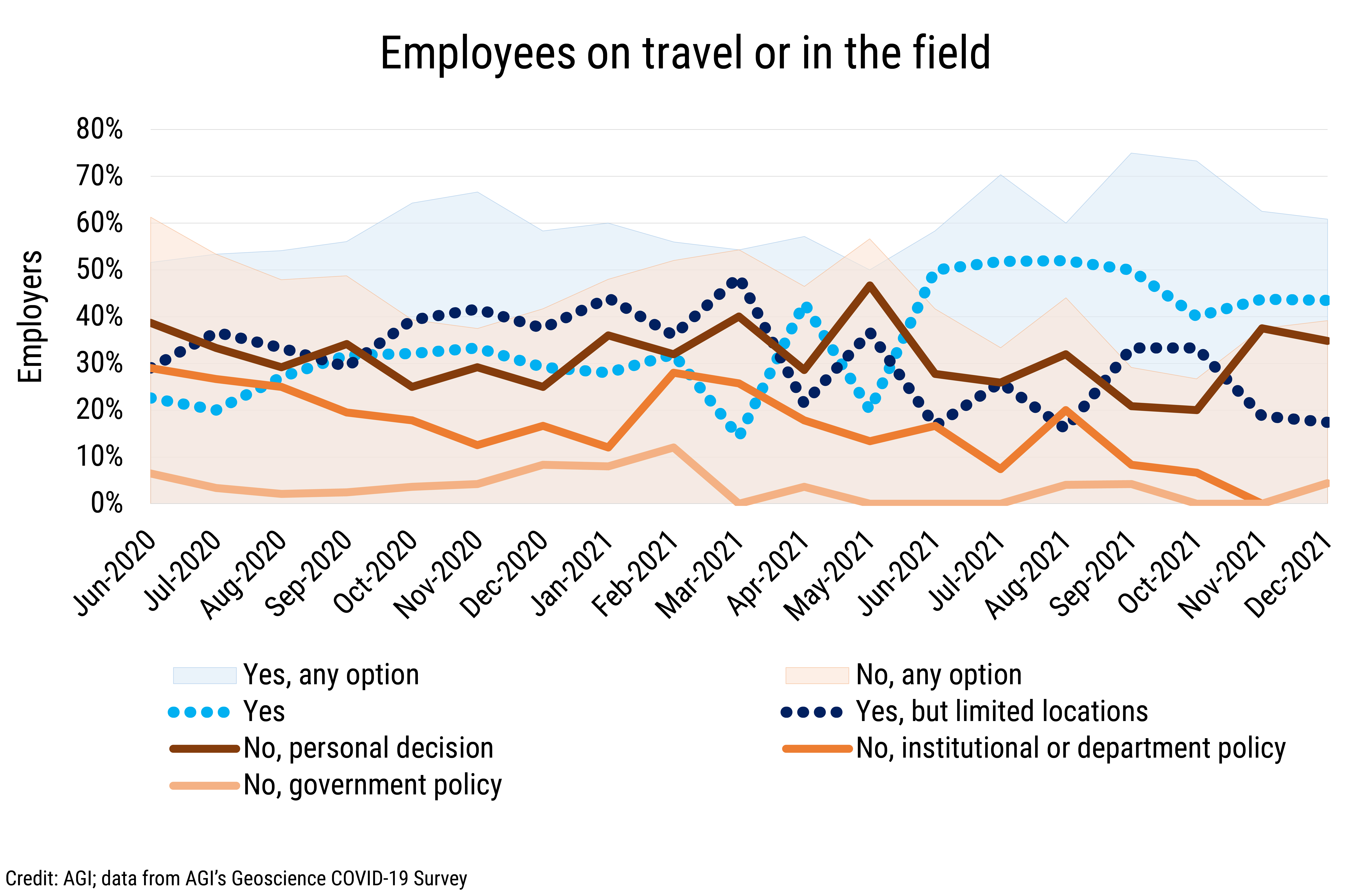
DB_2022-003 chart 04: Employees on travel or in the field (Credit: AGI; data from AGI's Geoscience COVID-19 Survey)
AGI
While in-office work increased through 2020 with the re-opening of
business activities, the percentage of employers offering remote work
options declined only slightly. By the end of 2021, 78% of employers
offered in-office work options, 91% offered remote work, and over
three-quarters of employers offered remote-first work policies (i.e.,
employees having the option to choose their work location). Access to
field sites and labs also increased through 2020 with easing of facility
restrictions, and by December 2021, 78% of employers allowed for field
activities and site visits and 43% provided lab access. The lower
percentage of employers offering lab access is reflective of the limited
number of companies with lab facilities.
The largest changes seen in workplace policies was in the types of
remote and in-office work approaches as employers have increased work
option flexibility. In February 2020, 57% of employers offered only
permanent in-office attendance, and this percentage decreased to 22% by
December 2021. Over the same period there was an increase in employers
offering limited in-office work and both permanent and in-office work
options. By December 2021, 22% of employers offered limited in-office
work options and just over one-third offered both permanent and
in-office work options.
Remote work policies changed in a similar though less dramatic way. The
percentage of employers offering both permanent and limited remote work
options increased from 14% to 30% between February 2020 and December
2021, whereas those employers offering only permanent or limited remote
work options declined from 29% to 26% and 39% to 35% respectively.
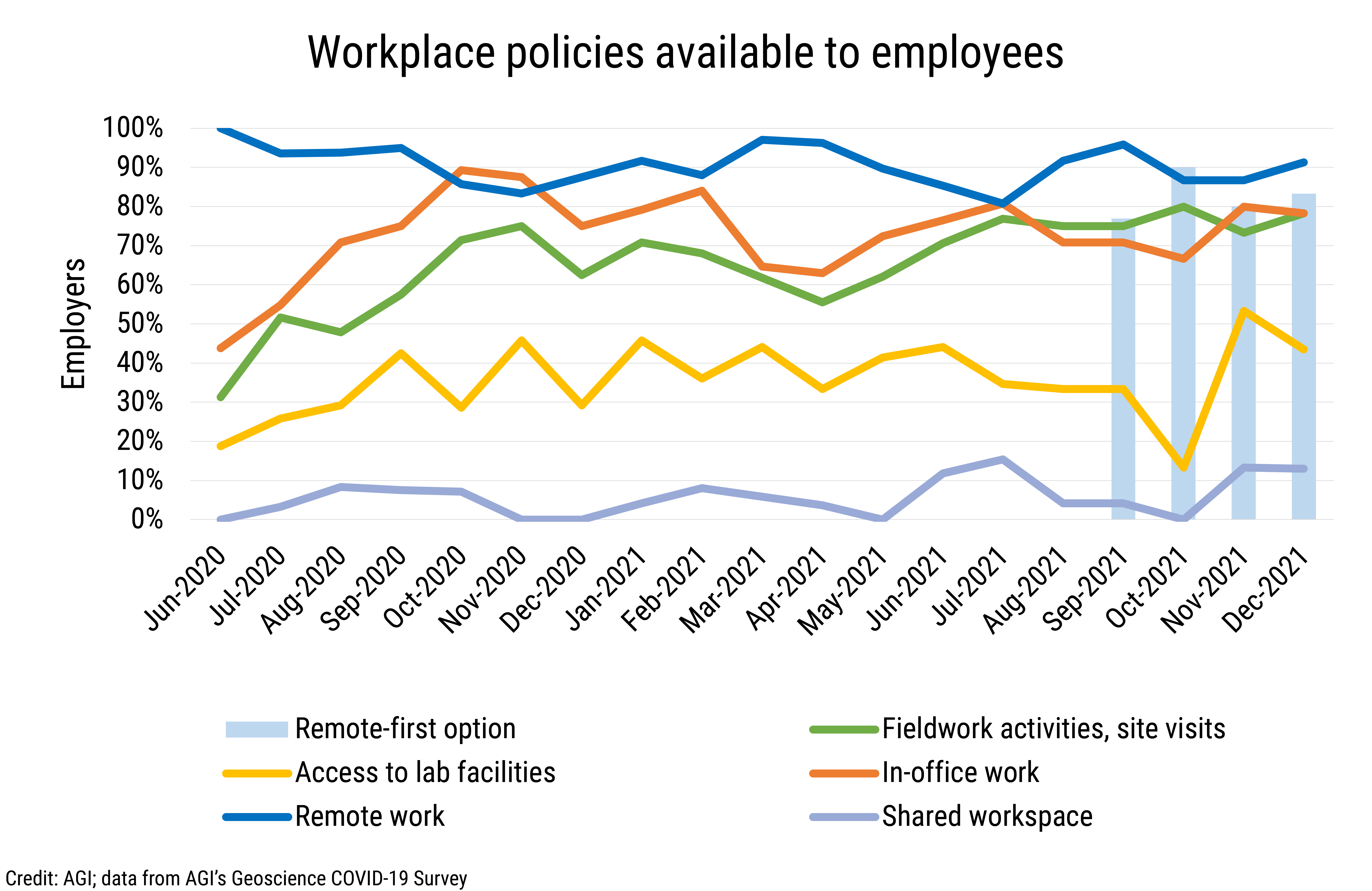
DB_2022-003 chart 05: Workplace policies available to employees (Credit: AGI; data from AGI's Geoscience COVID-19 Survey)
AGI
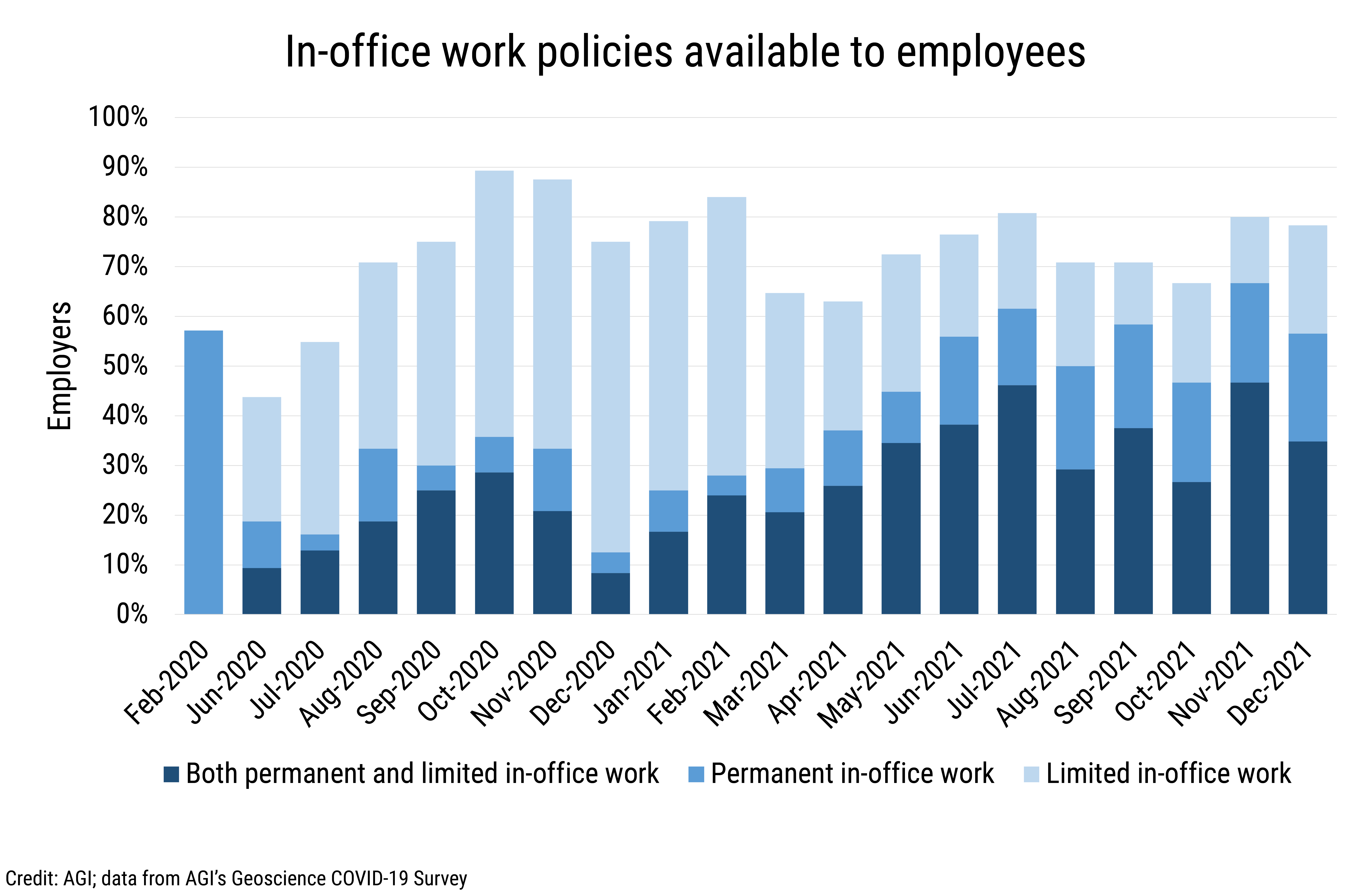
DB_2022-003 chart 06: In-office workplace policies available to employees(Credit: AGI; data from AGI's Geoscience COVID-19 Survey)
AGI
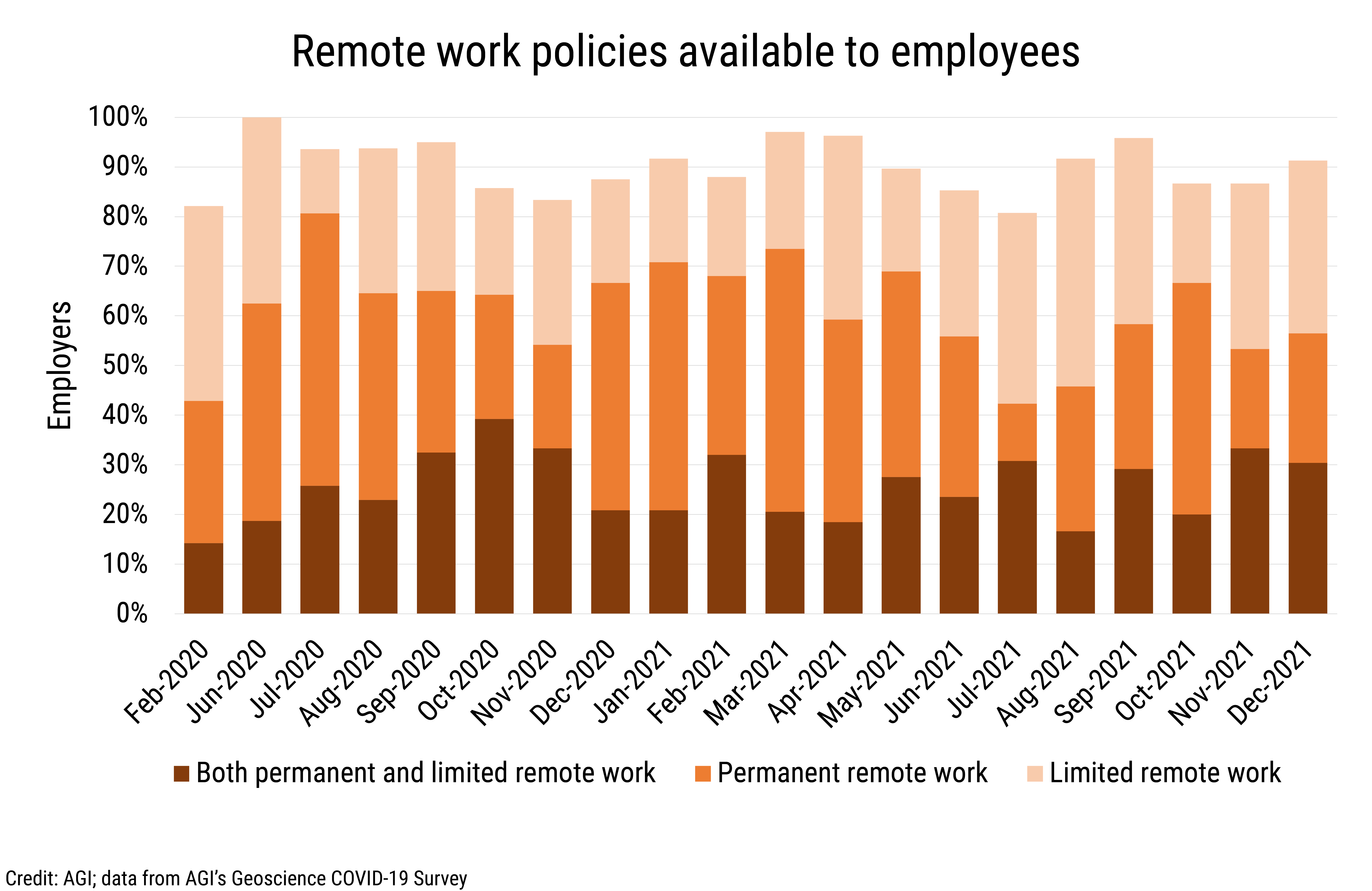
DB_2022-003 chart 07: Remote work policies available to employees(Credit: AGI; data from AGI's Geoscience COVID-19 Survey)
AGI
Although remote work continues to be the primary environment for
employees, employee distribution across work environments has
diversified during the pandemic and has adjusted in response to the
pandemic situation. In July 2021, employees worked across a wide array
of environments, with remote work and full-time office being the top
work locations. With the spread of the Delta variant, by October 2021,
the distribution of employees shifted away from in-office environments
and back to remote work environments.
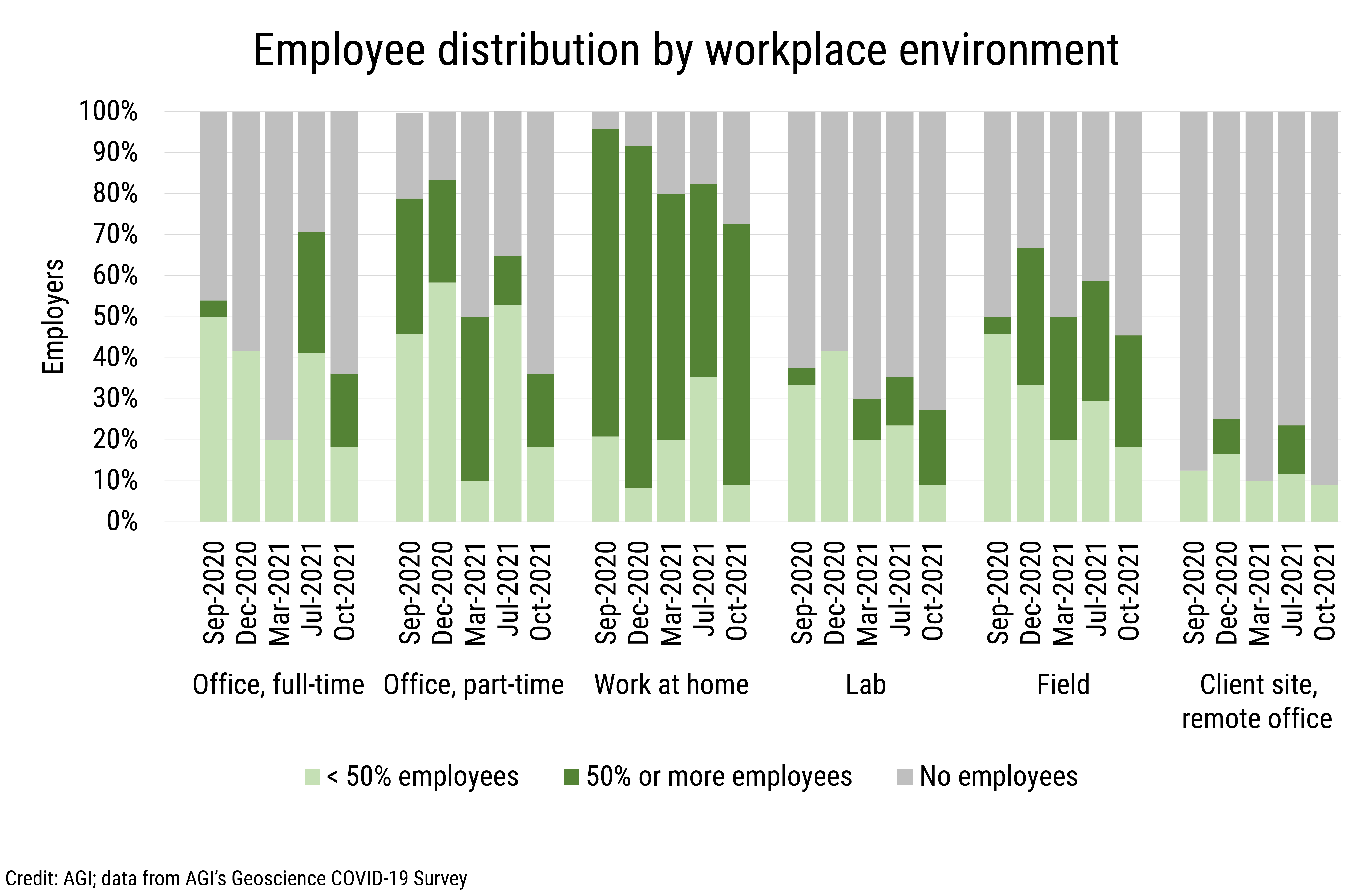
DB_2022-003 chart 08: Employee distribution by workplace environment (Credit: AGI; data from AGI's Geoscience COVID-19 Survey)
AGI
In August 2021, over half of employers indicated that they were
re-evaluating workplace policies and this percentage dropped to 20% by
October but increasing again to 50% by the end of the year. Office
policies under evaluation included work-from-home criteria, strategies
for managing in-office and remote work with regards to vaccination
status, mandates vs. incentivization for vaccines, and potential office
closures depending on the impacts of the Delta and Omicron variants. By
December 2021, employers mentioned that they were evaluating when and if
to have employees return to the office, including the frequency of
required in-office attendance. Some employers indicated they were
re-considering the need for permanent office space given positive
remote work experiences. Employers also were re-evaluating masking,
social distancing, and testing policies with regard to the spread of the
Omicron variant.
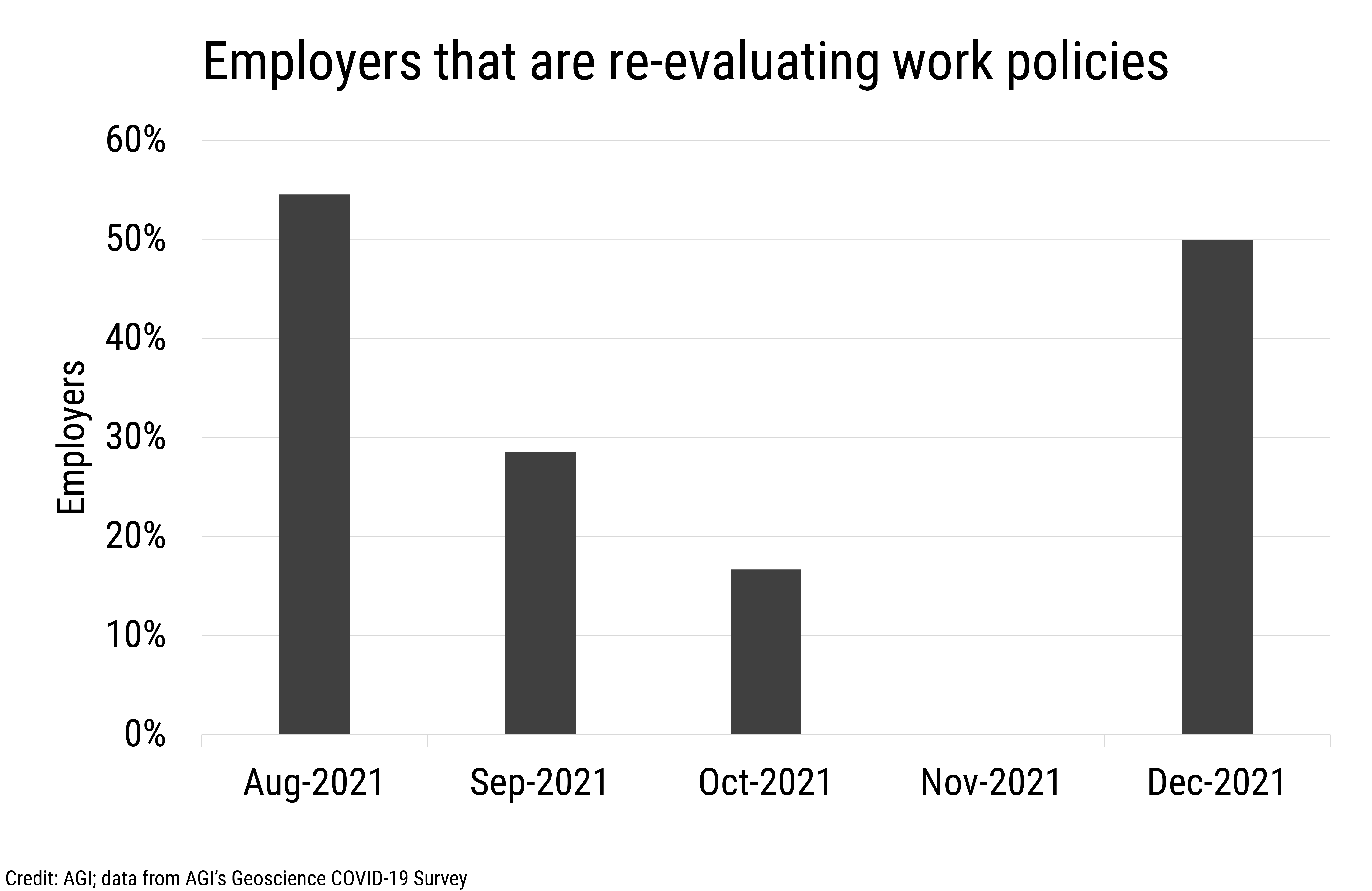
DB_2022-003 chart 09: Re-evaluation of work policies and remote-first options for employees (Credit: AGI; data from AGI's Geoscience COVID-19 Survey)
AGI
Over the duration of the pandemic, three-quarters of employers provided
technology equipment such as computers, monitors, printers, software,
office supplies, and furniture for employees who were working from home.
While 16% of companies provided financial assistance for employees to
set up their remote working environments, 19% of companies did not
provide any assistance for employees who worked from home. Training on
remote working technologies (i.e., using shared drives, setting up
network and printer connections, cyber security, etc.) was provided by
just over one-third of companies.
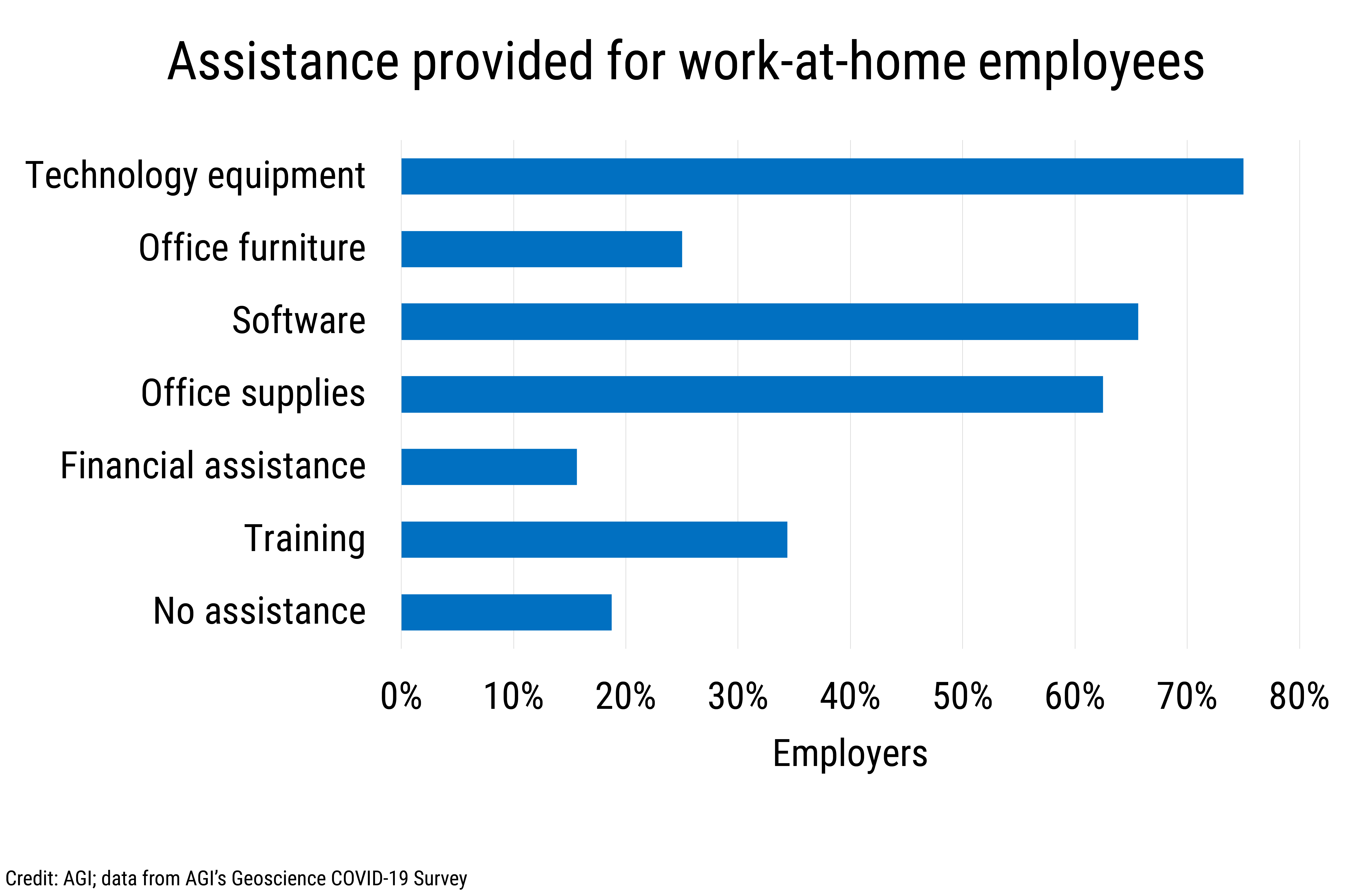
DB_2022-003 chart 10: Assistance provided for work-at-home employees (Credit: AGI; data from AGI's Geoscience COVID-19 Survey)
AGI
Note: Questions regarding re-evaluation of office policies were not
asked in November 2021.
Hiring
The percentage of employers with active job openings ranged between 30%
and 40% from late 2020 through the end of 2021, with a sharp increase in
openings between October and December 2021. Hiring lagged job openings
by a few months, with hiring peaking in June 2021 when 57% of employers
reported hiring geoscience talent. Although hiring contracted in
October, it grew again during the last months of 2021. By the end of
2021, over half of employers reported having job openings and half of
employers reported making hires. Employers reported primarily hiring
full-time geoscientists, with geoscience interns being hired during late
Spring through the summer months.
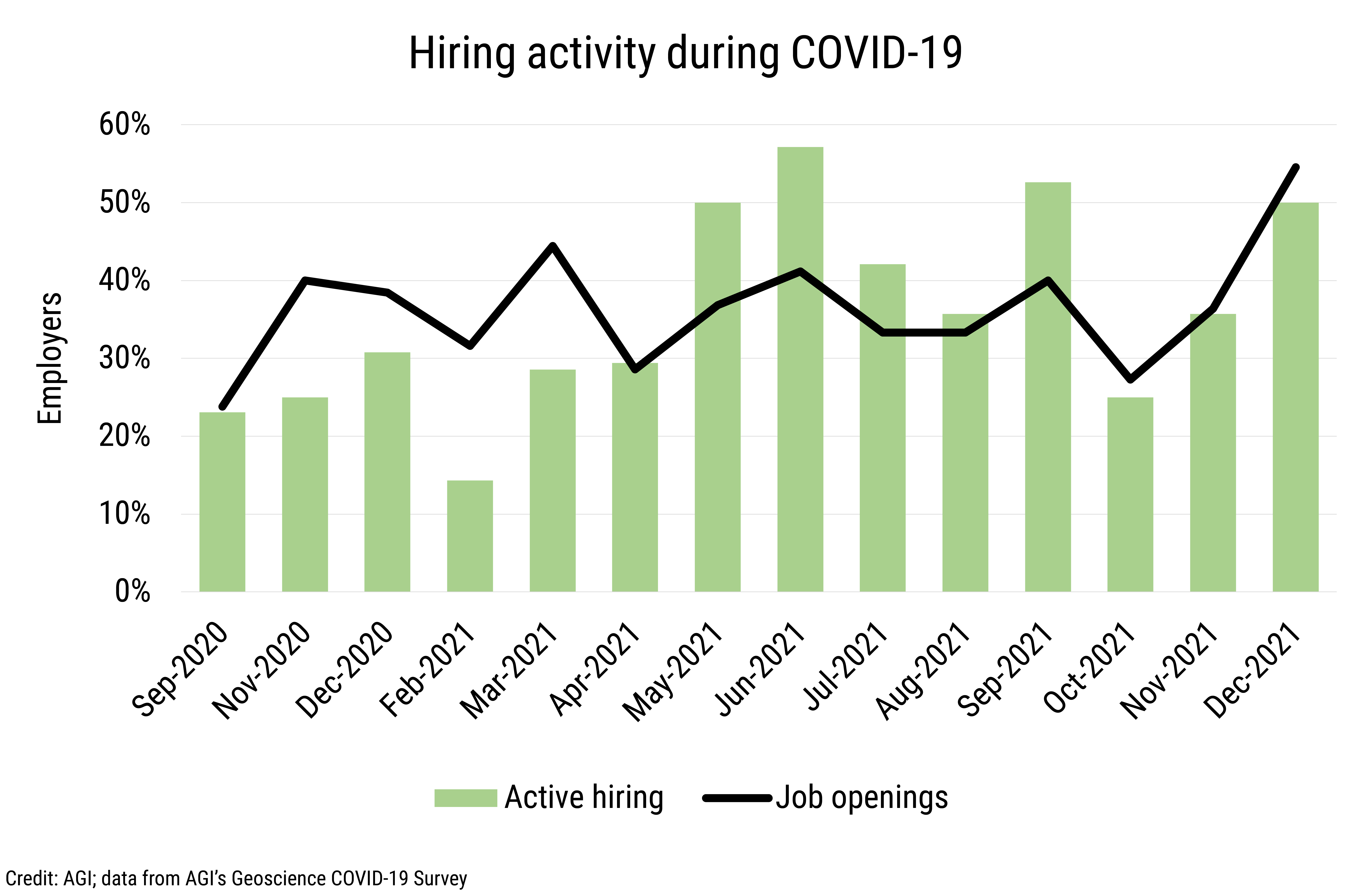
DB_2022-003 chart 11: Hiring activity during COVID-19 (Credit: AGI; data from AGI's Geoscience COVID-19 Survey)
AGI
A worker shortage has been widely reported across the economy during
2021. The geosciences experienced this as well, especially through the
first half of 2021. Beginning in July 2021, more than half of employers
reported no challenges to recruiting, hiring, and onboarding activities.
Recruitment continues to be a widely cited on-going challenge, with
between 27% and 38% of employers citing a lack of available talent to
fill vacancies. Onboarding new staff has also remained a challenge,
especially into remote working environments, with employers shifting to
virtual training for new hire training and onboarding. Funding and
budget constraints related to hiring were more prevalent issues through
the second quarter of 2021 than for the rest of the year.
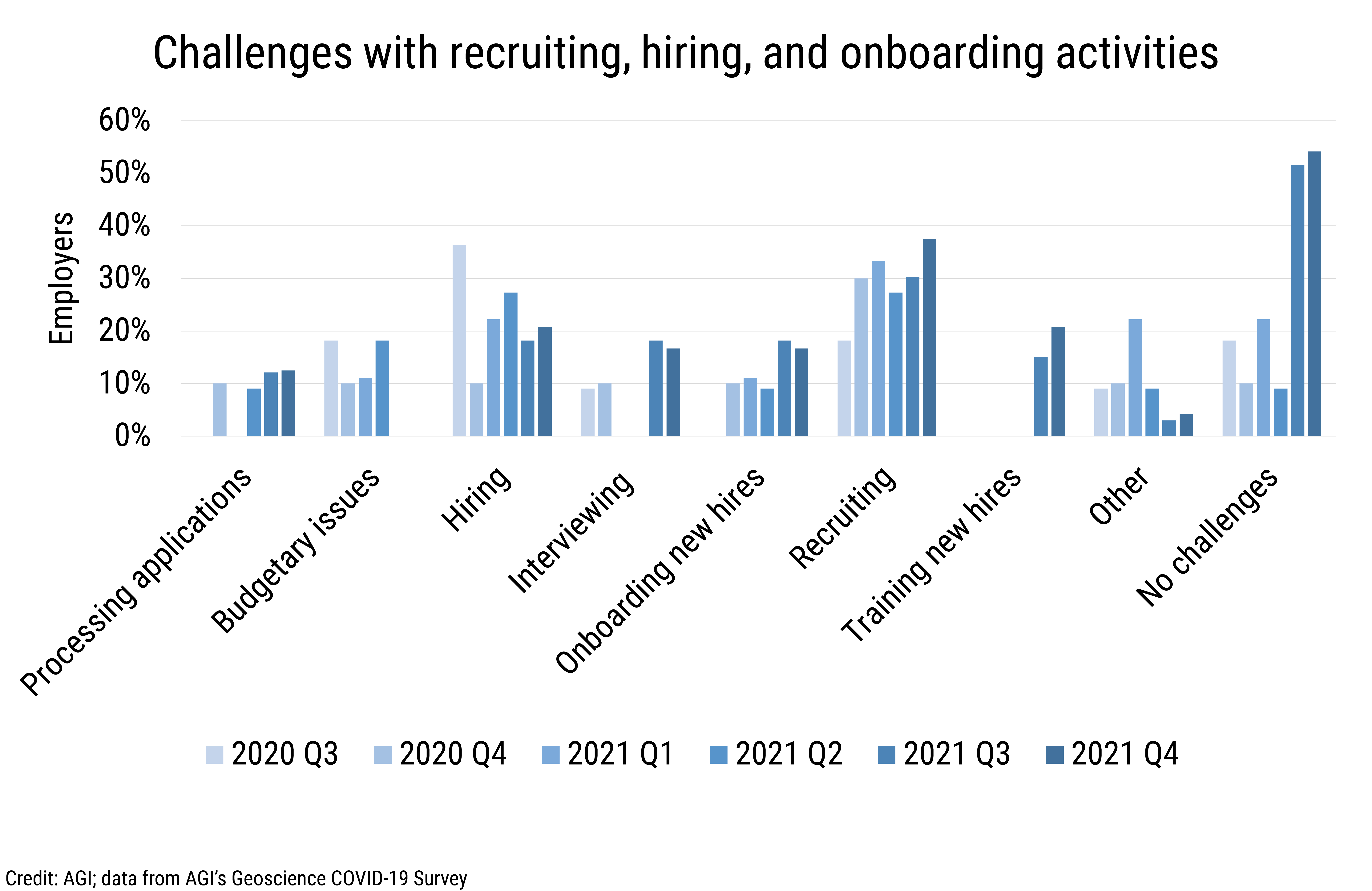
DB_2022-003 chart 12: Challenges with recruting, hiring, and onboarding activities (Credit: AGI; data from AGI's Geoscience COVID-19 Survey)
AGI
When asked about the skills and educational backgrounds of potential new
hires, 86% of employers indicated they hired geoscience bachelor’s
graduates, 81% hired geoscience master’s graduates, and 52% hired
geoscience doctorates. The top skills required by employers were field
skills, proficiency with virtual platforms, and data visualization and
mapping software, with proficiency with virtual platforms increasing in
importance between June and November 2021.
The top three preferred skills were project management, proficiency with
data visualization and mapping software, and database management.
Machine learning, artificial intelligence, and data science were of
minor consideration by employers. Employers also commented that they
looked for new hires that were motivated to learn and able to adapt to
the requirements of the job as well as individuals with technical
proficiency and practical experience. Nearly one-fifth of employers
reported that they had changed what they were looking for in potential
geoscience employees since the start of the pandemic, with most
commenting on the need for candidates that had demonstrated they could
work with minimal to no supervision.

DB_2022-003 chart 13: Employer preference for skillsets in new hires (Credit: AGI; data from AGI's Geoscience COVID-19 Survey)
AGI
Skills
While most employers reported that their employees were moderately to
extremely proficient with using virtual platforms and tools, they were
less proficient with collaborating virtually on projects. Employers
however have reported increased proficiency across all virtual skill
categories between 2020 and 2021 with the greatest improvement seen
project collaboration with colleagues. Approximately one-fifth of
employers reported increased proficiency among their employees with the
use of virtual tools for collaborative work and for presenting research
and projects virtually.
Employee proficiency with selected complementary technical skills such
as data visualization, database skills, and graphic design showed the
most improvement between February and September 2021, with nearly
one-fifth of employers noting improvements at the intermediate to expert
level across these categories. Approximately one-tenth of employers
noted improvements at the basic to novice level for skills related to
data science and programming between February and September 2021.

DB_2022-003 chart 14: Employee proficiency with selected virtual skills (Credit: AGI; data from AGI's Geoscience COVID-19 Survey)
AGI
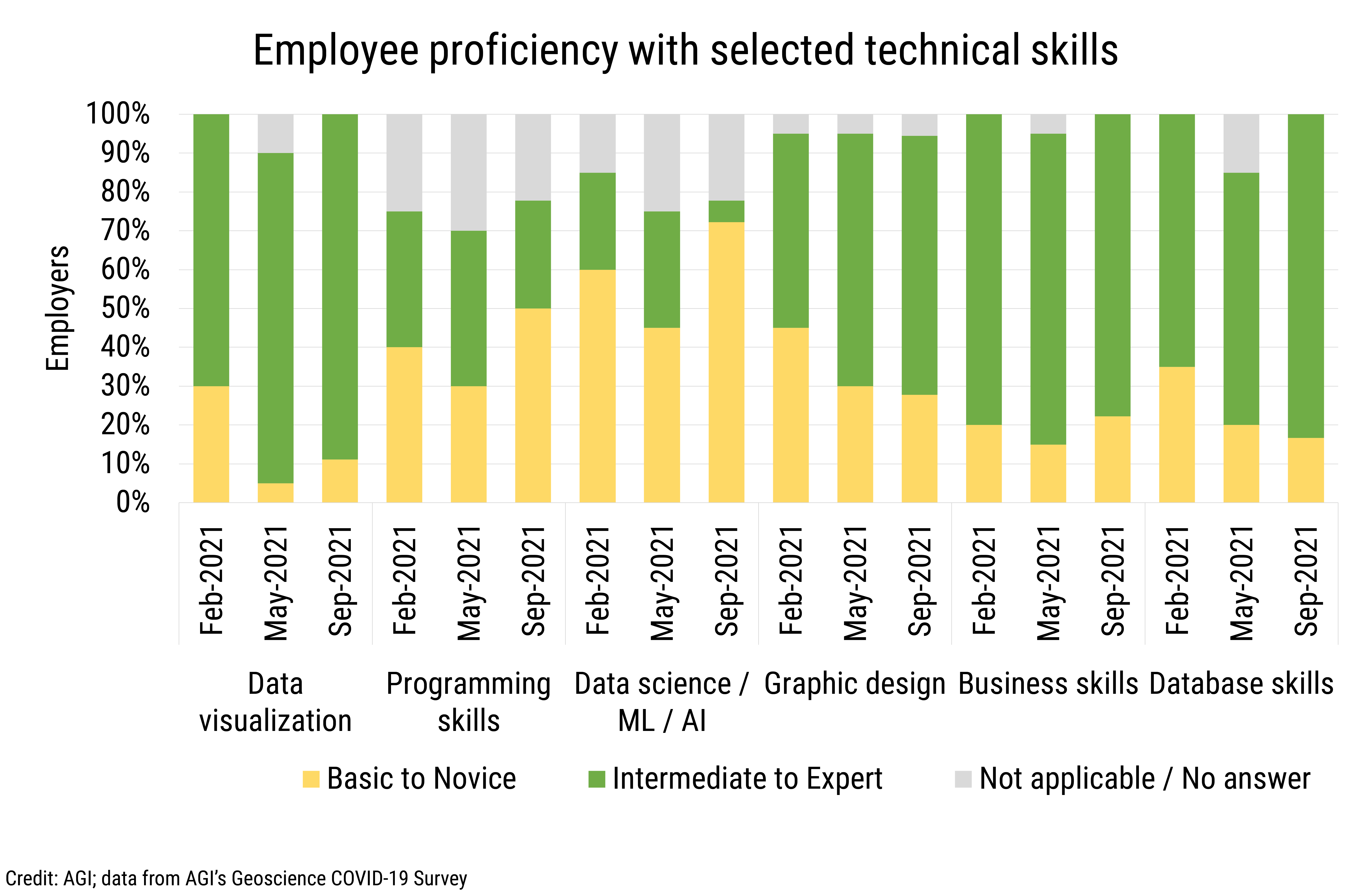
DB_2022-003 chart 15: Employee proficiency with selected technical skills (Credit: AGI; data from AGI's Geoscience COVID-19 Survey)
AGI
We will continue to provide current snapshots on the impacts of COVID-19
on the geoscience enterprise throughout the year. For more information
about the study, please visit:
www.americangeosciences.org/workforce/covid19
Funding for this project is provided by the National Science Foundation
(Award #2029570). The results and interpretation of the survey are the
views of the American Geosciences Institute and not those of the
National Science Foundation.